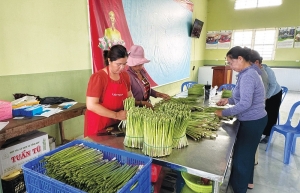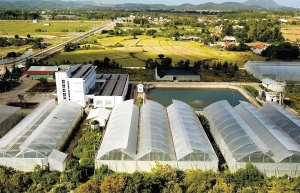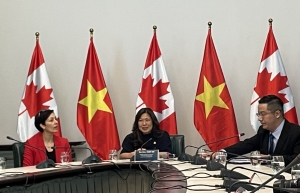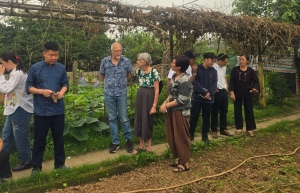VAT overhaul to boost agriculture prospects
 |
| VAT rate changes are likely to help support segments like fertiliser productions, photo Le Toan |
A draft VAT amendment law will be proposed to the National Assembly (NA) for comments in the seventh session taking place in May and June, before being able to be approved at the eighth working session scheduled to take place in October.
Last December, the National Assembly Standing Committee ratified a resolution on adjustment of the programme on development of laws and ordinances in 2024, in which the VAT law was included.
One of the highlights of the draft amendments is proposals for new VAT rates. Specifically, they shall limit the category of “exported services subject to 0 per cent VAT” to specifically cover three groups of services provided to foreign organisations and individuals: rental of vehicles for use outside Vietnam’s territory; international transportation; and aviation and maritime services provided directly for international transportation purposes.
Besides that, the draft shall reclassify fertiliser products, fishing vessels, and specialised machinery and equipment used for agricultural production to being subject to 5 per cent VAT instead of not being subject to VAT as currently.
Various obstructions
According to the Ministry of Finance (MoF), which drafts the amendments, since changes made in 2016, the implementation of the revised law has revealed numerous shortcomings affecting enterprises’ performance.
For example, all enterprises engaging in production and trade in goods used for agricultural and fishery production, such as fertiliser, specialised machinery, and fishing vessels, have been free from paying VAT.
“However, they are not allowed to declare and deduct it for their input goods and services, including activities involving investment and fixed assets purchase for their own performance,” stated an MoF report on the draft amendments submitted to the government last week.
“Instead, VAT payment is made for costs of products, leading to a rise in selling prices and a reduction in profits, meaning the items are less competitive than imported similar items.”
“Because they are not allowed to deduct it for input goods and services, enterprises do not want to expand investment, goods purchase, repair, and grade fixed assets to create high-quality products,” the MoF stated.
Associate Professor Nguyen Thi Thuy Duong, from the Institute for Banking and Finance under the National Economic University, commented that in the fertiliser production industry, Vietnam currently has to import a great deal volume of fertiliser from foreign markets where this item is subject to assorted VAT levels.
“When exporting fertiliser products into Vietnam, these exporters are refunded input VAT. Meanwhile, when imported into Vietnam, they are free from the tax, so foreign firms can lower selling prices, which have created unfair competition with items produced in Vietnam,” Duong analysed.
What is more, the state has lost an amount of revenue due to failure in collecting VAT from imported products, while import tariffs are either very low or reduced to zero, Duong said.
“This would mean local producers will continue facing difficulties. When fertiliser products are not subject to VAT, as a matter of fact, enterprises cannot deduct input VAT when selling them domestically, while the majority of input materials are subject to 10 per cent,” she continued.
As a result, enterprises have to increase production costs and suffer from a profit reduction, and they do not want to invest into renewing fixed assets, she explained.
“Additionally, enterprises also shift to exporting products because exportation can help them have VAT refunded thanks to a zero rate. This would lead to a reduction in fertiliser supply, meaning a rise in prices in the domestic market.”
Under the draft amendments to the law, when it comes to agricultural machinery and equipment, animal feed, and fishing vessels, at presents, these items are not subject to VAT.
However, this has made it difficult for producers in these sectors. They cannot declare and deduct VAT of input goods and services, including all activities about investing and purchasing fixed assets for production and business performance. And instead they have to increase costs and selling prices, meaning a reduction of profits. Finally, customers will have to buy products at high prices.
Meanwhile, according to the MoF, many types of machinery and equipment are used for many purposes in addition to agricultural production, such as water pumps, warming machinery, and diesel engine.
“This means it is difficult to determine which types of machines are subject to a 5 or 10 per cent VAT rate when they make correct declarations of the tax they have to pay. Moreover, tax and customs agencies also cannot control the usage purposes of the machines and equipment to impose a suitable rate,” the MoF stated.
Public post and telecommunications, internet services, and services that take care of zoos, public parks, and public lighting are currently not subject to VAT.
According to the MoF, many enterprises have been providing these services, but the fact that the businesses are not subject to VAT “is not suitable any longer because they cannot deduct it for input VAT and enjoy input a refund”.
A way out
According to the draft amendments to the law, the legislative body will revise the list of goods and services subject to VAT in a direction of reducing the number of such goods and services.
For instance, the MoF has been asked by the Ministry of Industry and Trade, the Vietnam Fertiliser Association, and domestic fertiliser producers to shift fertiliser products from not being subject to VAT to 5 per cent.
“Fertiliser should be subject to a 5 per cent VAT rate to support the industry. However, it is necessary to harmonise this rate with other types of taxes on fertiliser such as import and export taxes,” said Duong from the Institute for Banking and Finance. “The government also needs to control fertiliser export activities to prevent bad impacts on the domestic supplies. The export tariff for fertiliser needs to be maintained at a level of higher than 0 per cent.”
The MoF has also suggested that to help enterprises producing agricultural machinery and equipment, and fishing vessel out of difficulties and to help them achieve equal competition with imported similar items, “it is necessary for the NA to revise related regulations on these home-made products appropriately.”
| Assessment of existing 10 per cent VAT rate Clause 2 of Article 3 of the existing Law on Value-Added Tax stipulates a preferential rate of 5 per cent and a common one of 10 per cent. Vietnam is boosting its economic restructuring with the key task of promoting restructuring of budget revenues and expenditures, ensuring the safety of public debt and national finance. Vietnam’s revenues from imports and exports have decreased due to the implementation of tariff reduction commitments that Vietnam has signed in free trade agreements, along with reduced revenues from crude oil exports, and a reduction in the corporate income tax (CIT) from 32 to 20 per cent, which is aimed to increase the competitiveness of the economy. This has had a significant impact on the revenue structure of the state budget. Specifically, the proportion of crude oil revenue and revenue from export and import activities went down from about 39.1 per cent of total state budget revenue (equivalent to 10.3 per cent of GDP) on average in the 2006-2010 period to about 30.8 per cent of total state budget revenue on average in 2011-2015, and to around 14.5 per cent of total state budget revenue on average in 2016-2020. International practices show that many nations worldwide are now in a trend of restructuring state budget revenues, in which they strengthen the role of VAT, and gradually reduce import taxes in order to fulfill their commitments in the international community, while also gradually reducing CIT so as to increase the attractiveness of their investment environment. The number of nations applying VAT or goods and services taxes (GST) is on the rise, from about 140 countries in 2004 to 195 in 2020. According to International Monetary Fund statistics on tax rates of 164 countries and territories in 2020, there were 122 countries with common tax rates from 13 to 27 per cent; 26 countries have common taxes ranging from 10 to below 13 per cent; and 16 countries impose a common rate of below 10 per cent. Vietnam’s neighbouring countries such as Laos, Indonesia, and Cambodia also have a common tax rate of 10 per cent, China 13 per cent, and the Philippines 12 per cent. In some other countries, such as Canada, in addition to the federal government collecting GST, some state governments also collect this type of tax. To implement the Party’s policies and guidelines, in accordance with international VAT reform practices and trends, it is necessary to be research and apply an appropriate common tax rate. Source: Government report to the National Assembly Standing Committee |
 | Ninh Thuan inspired to form effective agriculture As Vietnam is stepping up efforts to cope with climate change, investment into adaptation activities will produce positive impacts in the short and long term. |
 | Phu Yen is on the journey to develop high-tech agriculture Agricultural production areas are being created in Phu Yen province with favourable natural conditions and high-tech agriculture. |
 | Sustainable livelihoods for female coffee producers in Son La province A new initiative aimed at providing technical support to female coffee producers in the northern moutainous province of Son La will bolster their already substantial contribution to tackling climate change. |
 | Canadian businesses focus on green energy and agriculture in Vietnam Canada's business community is looking forward to cooporating in agriculture, energy, and green and clean technology with Vietnam, said Mary Ng, Minister of Export Promotion, International Trade and Economic Development. |
 | Cultivating agricultural tourism model in Hanoi A tour with a difference for international visitors was launched on April 4 in Hanoi under a model developed by VietHarvest AgriTour. |
What the stars mean:
★ Poor ★ ★ Promising ★★★ Good ★★★★ Very good ★★★★★ Exceptional
 Tag:
Tag:
Related Contents
Latest News
More News
- Tax sector wraps up 2025 and sets priorities for next year (December 25, 2025 | 14:00)
- A tipping point for digital and hybrid wealth management in Vietnam (December 23, 2025 | 13:33)
- $250 million deal targets women-owned SMEs, sustainable agriculture (December 22, 2025 | 17:40)
- Stock market posts resilient 2025 performance (December 19, 2025 | 18:17)
- Citi Vietnam receives 2025 AmCham CSR recognition (December 19, 2025 | 16:35)
- As global green supply chain reshapes, will Vietnam be left behind? (December 19, 2025 | 08:00)
- Banks gear up for massive capital increases (December 18, 2025 | 17:04)
- Securing capital and efficiency for Vietnam’s 2026-2030 growth ambitions (December 17, 2025 | 10:00)
- Energy sector in need of blended finance mechanisms (December 17, 2025 | 09:00)
- Vietnam still has room to mobilise capital for sustainable growth (December 17, 2025 | 08:57)























 Mobile Version
Mobile Version